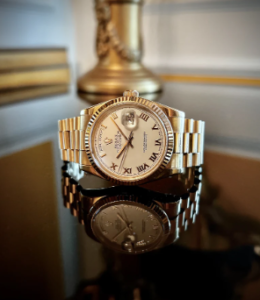
A 1959 Rolex Oyster Perpetual In 14k Yellow Gold
I have never been a fan of gold. Whether it’s watches, money clips, key rings, or just jewelry in general, I’ve always gravitated toward sterling silver and stainless steel. We all know what I’m talking about, right? Yes, this little 1959 Rolex OP changed my mind. Who would have guessed it, right? Give me a chance to make a case here, and I promise it will pay off.
1959 Rolex Oyster Perpetual Ref. 6569 in 14k yellow gold with JB Champions Jubilee bracelet
The added benefit of living in New York City as a watch head is attending the previews of the major auction houses. This gives me the opportunity to view, handle and learn about watches that don’t often grace the tables of HODINKEE. While I admit that I am not a gold watch owner, some very gold watches have certainly caught my eye over the years. At the top of my gold watch list is the “Paul Newman Lemon” Daytona, obviously. My interactions with most gold rolex replica watches usually come from a place of “this is out of my price range”, so why not shoot for the stars? Last June, Phillips New York auctioned one of the best examples on the market, which they called “El Limoncito” because it came from the original owner in Mexico, complete with a “Hecho in Mexico” Jubilee bracelet.
Now, we are talking here about a watch that sold at auction for around $2 million. Why, you ask? In your opinion, the “El Limoncito” is the ultimate all-gold sports watch. It was almost a religious experience to hold it at the auction preview. Since that fateful moment, I haven’t been drawn to Rolex gold in the same way. That is, until this relatively humble Ref. 6569 arrived at HODINKEE headquarters.
1959 Rolex Oyster Perpetual Ref. 6569 in 14k yellow gold with JB Champion Jubilee bracelet
I’ll admit my emotions are a few points lower than they were at Phillips, but this is still incredible. It’s made in the USA on a JB Champion Jubilee bracelet, the same weight as the “Hecho in Mexico” bracelet, with a dial shade that leans more towards lemon than the more standard Rolex champagne color. In some light, this dial is a bit rose-colored, but in direct sunlight, it has a more lemony feel to it against the yellow case. In 14k yellow gold with US market import markings and a US bracelet, we have here the Ref. 6569 we have here the OP companion to the Daytona “El Limoncito” model. 6264. If we could strip away the Daytona and Newman features, this is probably the watch that would be left. All the photos and details are right here in the store.
PH Week does explain how the flyback works in terms of being able to time consecutive events, which I guess is somewhat convenient. The real question for me is, if these movements are so difficult to develop, why is the French military so insistent on needing this feature? From what I can find, this feature would make waypoint-to-waypoint navigation much easier. I was led to believe that this would be more of a feature for helicopter pilots than for aircraft pilots, but still be very useful for both. Another interesting thing about these watches is that they usually have the FG and date stamped on the back, which stands for Fin Garantie or end of warranty. This watch is marked 2-4-81, which to me means they want the watch to last at least until then. The longer life span and higher production numbers mean these are some of the more readily available vintage complicated chronographs. Plus, whether or not the features are useful to civilians in modern life, it means you can get a ton of vintage swiss replica watches for your money. Just take a look at this piece here.
This watch also represents an interesting period in the history of Swiss watchmaking. It was a time when Swiss watch companies often partnered with American operations, such as Longines, Vacheron Constantin, and LeCoultre, all with Wittnauer or Breitling with Wachmann. This was mainly for import and distribution purposes, and this Gallet by Racine follows a similar model between Gallet & Co. of Switzerland and Jules Racine, the American importer based in New York. That’s why we have the U.S. import stamp “JXR”, which was specified on the movement for Gallet and Racine by Excelsior Park, the Swiss-based company that supplied Gallet with the movement. There was a lot of collaboration here to make this watch happen.
On the surface, it is a true 1970s watch, from the large tonneau-shaped case with a clear sunburst decoration on the front to the orange accents on the telemeter scale and chronograph hands. But beyond that, it inherits some classic elements from the previous era, starting with the black acrylic bezel, the 3-register style, and the luminous hour markers that are somewhat reminiscent of the Omega Speedmaster. Oddly enough, it’s easier to wear than you might think. There’s no harm in experimentation and curiosity about the “unknown”. You might find something you never thought you’d have in your collection.